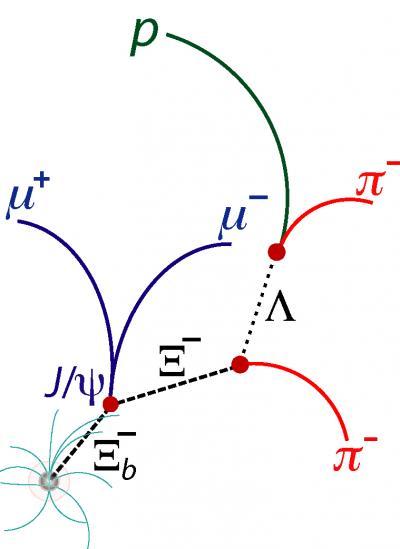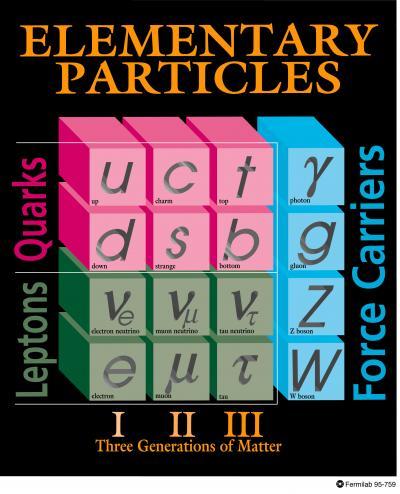Physicists of the DZero experiment at the Department of Energy's Fermi National Accelerator Laboratory have discovered a new heavy particle, the Îb(pronounced "zigh sub b") baryon, with a mass of 5.774±0.019 GeV/c2, approximately six times the proton mass.
The newly discovered electrically charged Îb baryon, also known as the "cascade b," is made of a down, a strange and a bottom quark. It is the first observed baryon formed of quarks from all three families of matter. Its discovery and the measurement of its mass provide new understanding of how the strong nuclear force acts upon the quarks, the basic building blocks of matter. The decay pattern of the Ξb particle. Credit: Fermilab
The decay pattern of the Ξb particle. Credit: Fermilab
The DZero experiment paper is here.
"Knowing the mass of the cascade b baryon gives scientists information they need in order to develop accurate models of how individual quarks are bound together into larger particles such as protons and neutrons," said physicist Robin Staffin, Associate Director for High Energy Physics for the Department of Energy's Office of Science.
The cascade b is produced in high-energy proton-antiproton collisions at Fermilab's Tevatron. A baryon is a particle of matter made of three fundamental building blocks called quarks. The most familiar baryons are the proton and neutron of the atomic nucleus, consisting of up and down quarks. Although protons and neutrons make up the majority of known matter today, baryons composed of heavier quarks, including the cascade b, were abundant soon after the Big Bang at the beginning of the universe.
The Standard Model elegantly summarizes the basic building blocks of matter, which come in three distinct families of quarks and their sister particles, the leptons. The first family contains the up and down quarks. Heavier charm and strange quarks form the second family, while the top and bottom, the heaviest quarks, make the third. The strong force binds the quarks together into larger particles, including the cascade b baryon. The cascade b fills a missing slot in the Standard Model. Six quarks -- up, down, strange, charm, bottom and top -- are the building blocks of matter. Protons and neutrons are made of up and down quarks, held together by the strong nuclear force. The DZero experiment has discovered the Cascade-b particle, which contains a down quark (d), strange quark (s) and bottom quark (b). It is the first particle ever observed with one quark from each generation of particles. Credit: Fermilab
Six quarks -- up, down, strange, charm, bottom and top -- are the building blocks of matter. Protons and neutrons are made of up and down quarks, held together by the strong nuclear force. The DZero experiment has discovered the Cascade-b particle, which contains a down quark (d), strange quark (s) and bottom quark (b). It is the first particle ever observed with one quark from each generation of particles. Credit: Fermilab
Prior to this discovery, only indirect evidence for the cascade b had been reported by experiments at the Large Electron-Positron collider at the CERN Laboratory near Geneva, Switzerland. For the first time, the DZero experiment has positively identified the cascade b baryon from its decay daughter particles in a remarkably complex feat of detection. Most of the particles produced in high-energy collisions are short-lived and decay almost instantaneously into lighter stable particles. Particle detectors such as DZero measure these stable decay products to discover the new particles produced in the collision.
Once produced, the cascade b travels several millimeters at nearly the speed of light before the action of the weak nuclear force causes it to disintegrate into two well-known particles called J/Ø ("jay-sigh") and Î- ("zigh minus"). The J/Ø then promptly decays into a pair of muons, common particles that are cousins of electrons. The Î-baryon, on the other hand, travels several centimeters before decaying into yet another unstable particle called a &Lambda ("lambda") baryon, along with another long-lived particle called a pion. The &Lambda baryon too can travel several centimeters before ultimately decaying to a proton and a pion. Sifting through data from trillions of collisions produced over the last five years to identify these final decay products, DZero physicists have detected 19 cascade b candidate events. The odds of the observed signal being due to something other than the cascade b are estimated to be one in 30 million.###
DZero is an international experiment of about 610 physicists from 88 institutions in 19 countries. It is supported by the Department of Energy, the National Science Foundation, and a number of international funding agencies. Fermilab is a national laboratory funded by the Office of Science of the U.S. Department of Energy, operated under contract by Fermi Research Alliance, LLC.